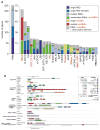Evolutionary conservation and expression of human RNA-binding proteins and their role in human genetic disease
- PMID: 25201102
- PMCID: PMC4180674
- DOI: 10.1007/978-1-4939-1221-6_1
Evolutionary conservation and expression of human RNA-binding proteins and their role in human genetic disease
Abstract
RNA-binding proteins (RBPs) are effectors and regulators of posttranscriptional gene regulation (PTGR). RBPs regulate stability, maturation, and turnover of all RNAs, often binding thousands of targets at many sites. The importance of RBPs is underscored by their dysregulation or mutations causing a variety of developmental and neurological diseases. This chapter globally discusses human RBPs and provides a brief introduction to their identification and RNA targets. We review RBPs based on common structural RNA-binding domains, study their evolutionary conservation and expression, and summarize disease associations of different RBP classes.
Figures






References
Publication types
MeSH terms
Substances
Grants and funding
LinkOut - more resources
Full Text Sources
Other Literature Sources
Medical

